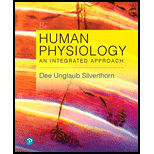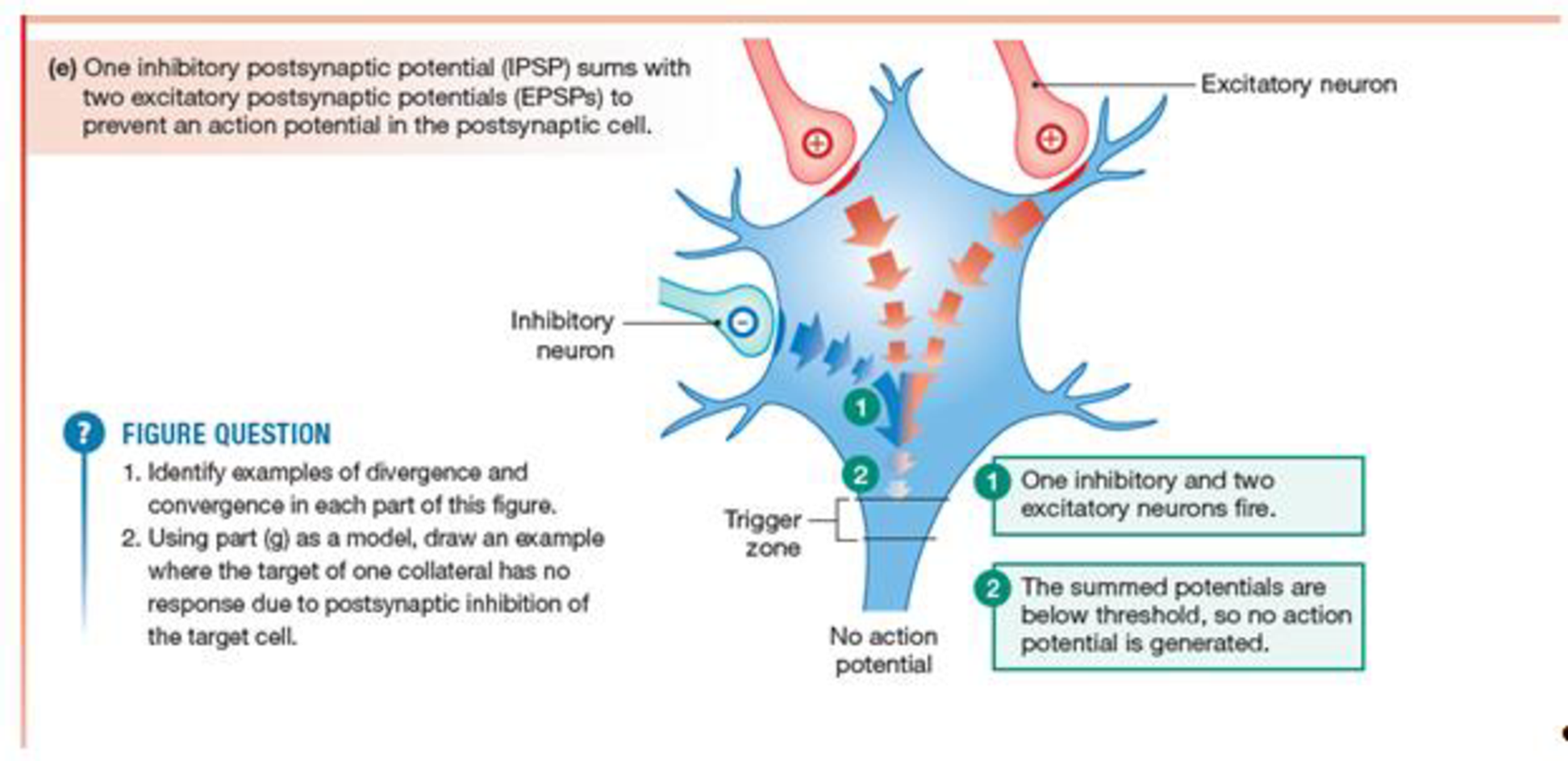
Human Physiology: An Integrated Approach (8th Edition)
8th Edition
ISBN: 9780134605197
Author: Dee Unglaub Silverthorn
Publisher: PEARSON
expand_more
expand_more
format_list_bulleted
Textbook Question
Chapter 8.5, Problem 27CC
In Figure 8.24e, assume the postsynaptic neuron has a resting membrane potential of −70 mV and a threshold of −55 mV. If the inhibitory presynaptic neuron creates an IPSP of −5 mV and the two excitatory presynaptic neurons have EPSPs of 10 and 12 mV, will the postsynaptic neuron fire an action potential?

Expert Solution & Answer
Want to see the full answer?
Check out a sample textbook solution
Students have asked these similar questions
If a postsynaptic cell has synapses from five different cells, and three cause EPSPs and two of them cause IPSPs, give an example of a series of depolarizations and hyperpolarizations that would result in the neuron reaching threshold.
Which of the following combinations of spatial summation of postsynaptic potentials (PSP) would result in an action potential in a typical neuron? The voltage given for each PSP is measured as it reaches the axon hillock.
Axon A EPSP 25 mV & axon B IPSP 10 mV
Axon A IPSP 25 mV & axon B EPSP 10 mV
Axon A IPSP 5 mV & axon B IPSP 5 mV
Axon A EPSP 5 mV & axon B EPSP 5 mV
In an experiment, the extracellular [Na+] surrounding a nerve cell was reduced from 145 to 45 mM. Which of the following is the most likely effect of this on action potentials?
No action potentials would occur because the concentration of extracellular Na+ is too low.
The membrane potential would become more negative so the threshold for action potential generation could not be reached.
The nerve cell would still produce an action potential but its amplitude would be reduced and the depolarisation phase would be slower.
The nerve cell would still produce an action potential but its amplitude would be reduced and the depolarization phase would be more rapid.
Chapter 8 Solutions
Human Physiology: An Integrated Approach (8th Edition)
Ch. 8.1 - Organize the following terms describing functional...Ch. 8.2 - Where do neurohormone-secreting neurons terminate?Ch. 8.2 - What is the difference between a nerve and a...Ch. 8.2 - Draw a chain of three neurons that synapse on one...Ch. 8.2 - What is the primary function of each of the...Ch. 8.2 - Name the two glial cell types that form myelin....Ch. 8.3 - Given the values in Table 8.2, use the Nernst...Ch. 8.3 - Would a cell with a resting membrane potential of...Ch. 8.3 - Would the cell membrane depolarize or...Ch. 8.3 - Match each ions movement with the type of graded...
Ch. 8.3 - Prob. 11CCCh. 8.3 - What is the difference between conductance and...Ch. 8.3 - If you put ouabain, an inhibitor of the Na+-K+...Ch. 8.3 - The pyrethrin insecticides, derived from...Ch. 8.3 - When Na+ channel gates are resetting, is the...Ch. 8.3 - A stimulating electrode placed halfway down an...Ch. 8.3 - Place the following neurons in order of their...Ch. 8.4 - Prob. 18CCCh. 8.4 - Prob. 19CCCh. 8.4 - Prob. 20CCCh. 8.4 - Prob. 21CCCh. 8.4 - Prob. 22CCCh. 8.4 - Classify the H+-neurotransmitter exchange as...Ch. 8.4 - Prob. 24CCCh. 8.4 - Prob. 25CCCh. 8.4 - Is Na+-dependent neurotransmitter reuptake...Ch. 8.5 - In Figure 8.24e, assume the postsynaptic neuron...Ch. 8.5 - In the graphs of Figure 8.24a, b, why doesnt the...Ch. 8.5 - Prob. 29CCCh. 8.5 - Prob. 30CCCh. 8 - List the three functional classes of neurons, and...Ch. 8 - Somatic motor neurons control __________, and...Ch. 8 - Prob. 3RQCh. 8 - Prob. 4RQCh. 8 - Prob. 5RQCh. 8 - Prob. 6RQCh. 8 - Axonal transport refers to the (a) release of...Ch. 8 - Match the numbers of the appropriate...Ch. 8 - Arrange the following events in the proper...Ch. 8 - List the four major types of ion channels found in...Ch. 8 - Prob. 11RQCh. 8 - An action potential is (circle all correct...Ch. 8 - Choose from the following ions to fill in the...Ch. 8 - What is the myelin sheath?Ch. 8 - List two factors that enhance conduction speed.Ch. 8 - Prob. 16RQCh. 8 - Draw and label a graph of an action potential....Ch. 8 - Prob. 18RQCh. 8 - Prob. 19RQCh. 8 - Create a map showing the organization of the...Ch. 8 - Prob. 21RQCh. 8 - Prob. 22RQCh. 8 - Prob. 23RQCh. 8 - Prob. 24RQCh. 8 - The presence of myelin allows an axon to (choose...Ch. 8 - Define, compare, and contrast the following...Ch. 8 - Prob. 27RQCh. 8 - Prob. 28RQCh. 8 - Prob. 29RQCh. 8 - Prob. 30RQCh. 8 - An unmyelinated axon has a much greater...Ch. 8 - The GHK equation is sometimes abbreviated to...Ch. 8 - In each of the following scenarios, will an action...
Knowledge Booster
Learn more about
Need a deep-dive on the concept behind this application? Look no further. Learn more about this topic, biology and related others by exploring similar questions and additional content below.Similar questions
- Conformational changes in channel proteins brought about by voltage changes are responsible for opening and closing Na+ and K+ gates during the generation of an action potential. (True or false?)arrow_forwardFigure 35.11 Potassium channel blockers, such as amiodarone and procainamide, which are used to treat abnormal electrical activity in the heart, called cardiac dysrhythmia, impede the movement of K+ through voltage-gated K+ channels. Which part of the action potential would you expect potassium channels to affect?arrow_forwardIf the postsynaptic cell's plasma membrane were to become substantially more permeable to Na+, you would expect the membrane potential to [depolarize, hyperpolarize] __________________. You would expect the membrane potential to depolarize if the extracellular K+ concentration were to [increase, decrease] ______________. a.) hyperpolarize, decrease b.) depolarize, decrease c.) depolarize, decrease d.) hyperpolarize, increasearrow_forward
- Why does neuronal function require the voltage-gated K+ channels to open moreslowly than the voltage-gated Na+ channels and how would you expect the voltage-gated K+ channels to affect the shape of an action potential curve?arrow_forwardSequence the following list of events of a neuronal action potential by placing 1 next to the first event, 2 next to the second event, and so on. a. _____ The activation gates of voltage-gated Na+ channels open, Na+ flood the cytoplasm, and depolarization occurs. b. _____ K+ continue to flow out of the axon until the membrane is hyperpolarized. c. _____ Local potentials cause the membrane to depolarize to threshold. d. _____ The inactivation gates of voltage-gated Na+ channels close as voltage-gated K+ channels open, K+ begin to exit the axon, and repolarization begins. e. _____ Repolarization continues and Na+ channels return to restingarrow_forwardPhotoreceptor cells form glutamatergic synapses onto bipolar cells and when photoreceptor cells are depolarized the release of glutamate into the synapse is increased. One class of bipolar cells, (called OFF bipolar cells) have excitatory glutamate receptors in their post-synaptic specialization. What happens to the membrane potential of OFF bipolar cells when photoreceptors are illuminated?arrow_forward
- A change in the axon membrane potential from -70 mV to -64 mV would be called a depolarization polarization hyperpolarization potentialarrow_forwardDraw details of the repolarization phase of an action potential from the following descriptions of the sequences of AfterHyperPolarization (AHP) and AfterDePolarization (ADP) sequences. Make the distinct phases clear and noticeable (5 % each) A complex AHP consisting of a first component AHP, an ADP, and a second component AHP before repolarization to resting membrane potential a first fast AHP component, followed by a slower AHP, followed by a fast ADP, and a second late AHP component before repolarization to restarrow_forwardDefine the following terms: a. Resting membrane potential b. Graded membrane potential c. Action potential d. Depolarization e. Repolarization f. Hyperpolarizationarrow_forward
- What is the expected resting membrane potential (in mV) of a neuron that is typical in all ways except for possessing an intracellular potassium concentration of 94 mM and double the normal resting permeability to sodium?arrow_forwardHow much of a change in the membrane potential is necessary for the summation of postsynaptic potentials to result in an action potential being generated?arrow_forwardIf sodium and potassium ions are both positively charged, what causes the negative membrane potential in a resting neuron?arrow_forward
arrow_back_ios
arrow_forward_ios
Recommended textbooks for you
 Human Physiology: From Cells to Systems (MindTap ...BiologyISBN:9781285866932Author:Lauralee SherwoodPublisher:Cengage Learning
Human Physiology: From Cells to Systems (MindTap ...BiologyISBN:9781285866932Author:Lauralee SherwoodPublisher:Cengage Learning Biology 2eBiologyISBN:9781947172517Author:Matthew Douglas, Jung Choi, Mary Ann ClarkPublisher:OpenStax
Biology 2eBiologyISBN:9781947172517Author:Matthew Douglas, Jung Choi, Mary Ann ClarkPublisher:OpenStax

Human Physiology: From Cells to Systems (MindTap ...
Biology
ISBN:9781285866932
Author:Lauralee Sherwood
Publisher:Cengage Learning

Biology 2e
Biology
ISBN:9781947172517
Author:Matthew Douglas, Jung Choi, Mary Ann Clark
Publisher:OpenStax
Nervous System - Get to know our nervous system a bit closer, how does it works? | Neurology; Author: FreeMedEducation;https://www.youtube.com/watch?v=6O-0CVAgaEM;License: Standard youtube license